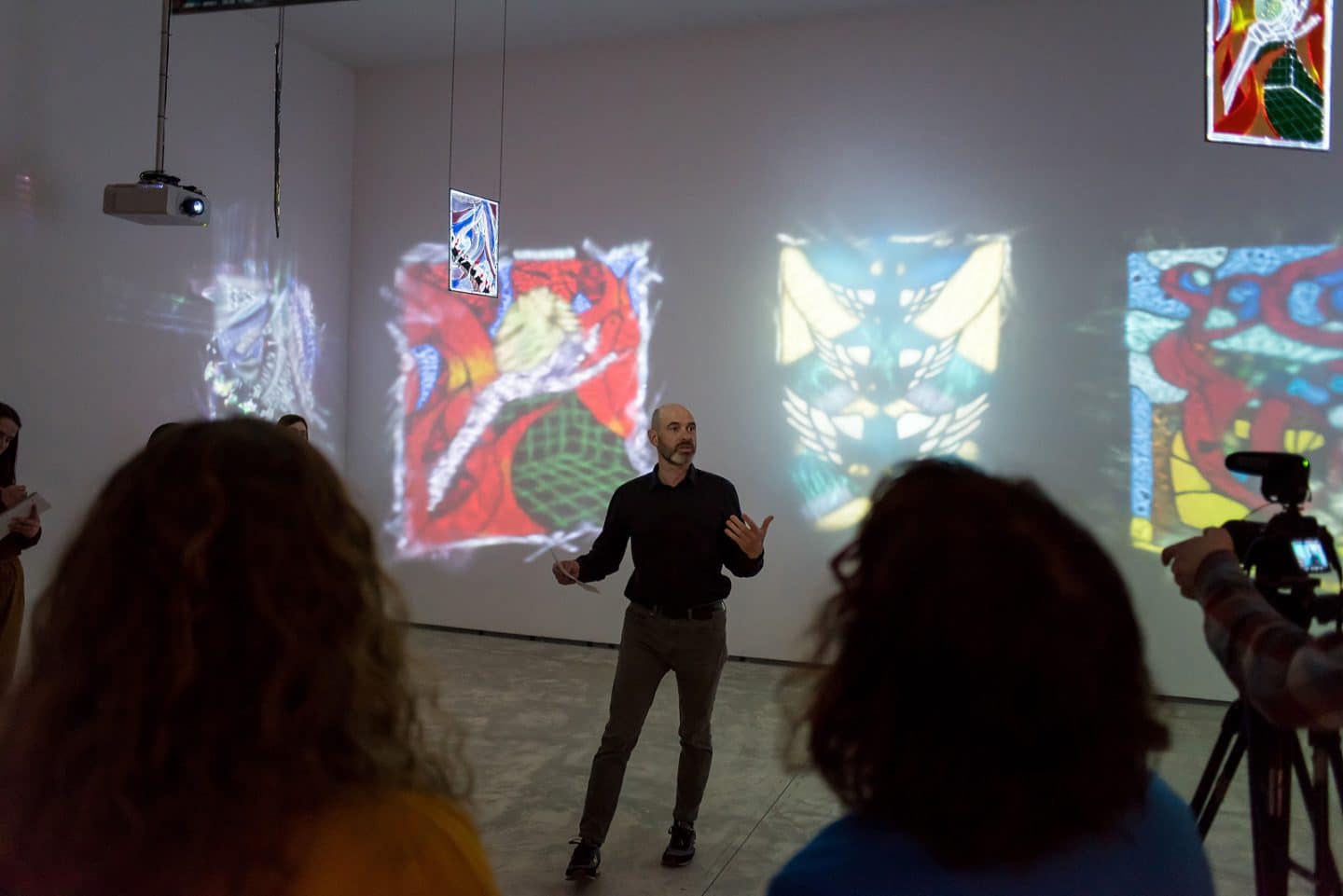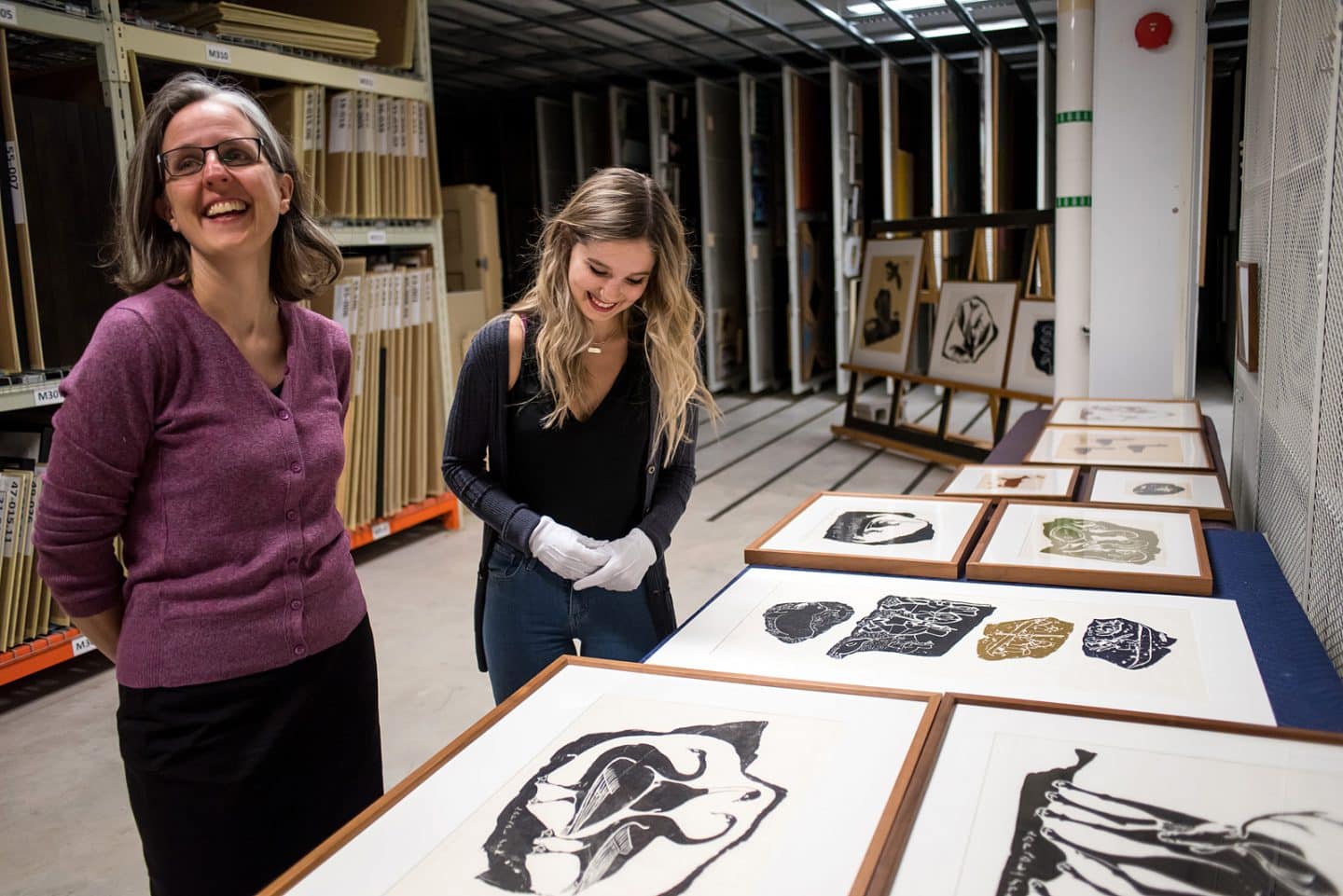For the past ten years, museum curators around the world have come together for this annual one-day event where members of the public can take to social media and ask curators everything and anything. Here’s a look at some of our favourite Q&A’s from our participating curators: Alicia Boutilier, Chief Curator/Curator of Canadian Historical Art; Marla Dobson, Assistant Curator, Canadian Art; and Sunny Kerr, Curator of Contemporary Art.
AB: While undertaking an graduate degree in Canadian art history, I had an assistantship at the university’s art gallery and an inspiring professor who was always making connections between academic and public work with art. My first real job was as a gallery educator, which was an incredible experience—to be able to engage with visitors, to see what children see in art. I carry that experience with me in curating.
MD: My road to becoming an art curator has been circuitous. I was first involved in the museum sector in my late teens when I volunteered as a docent for a historic house museum in Toronto. I completed an undergraduate degree in History, then a master’s degree in Museum Studies, finally a PhD in Art History. However, between and during those degrees I worked, volunteered and interned in various museum environments ranging from Bellevue House National Historic Site, the Museum of Health Care, the museum at Westminster Abbey in the UK, Black Creek Pioneer Village, and the Art Gallery of Ontario. My involvement at the Agnes began as a first-year grad student at Queen’s University where I completed an internship for course credit. I then held roles as a Collections Assistant, Installation Assistant, Assistant Curator of Academic Outreach, and finally now, as the Assistant Curator of Canadian Art.
SK: I became a visual artist first, while studying toward an English degree. Meanwhile, I missed playing in bands and its collaborative energy, so as an artist, I started working with art collectives. I worked for and was influence by Public Access and joined WayUpWayDown with Yam Lau and Tania Ursomarzo. Later I worked with YYZ, Pleasure Dome, Agitated Plover Salon, Princess Towers Notions Group and Corridor Culture, for example. My first jobs were in art school library, arts/culture publishing, teaching assistance at York, OCAD and Queen’s, and student and education program coordination at the University of Toronto Art Centre. Outside of these jobs, I was always organizing DIY artistic/curatorial projects.
AB: Exhibitions, whether solo-curated or co-curated are collaborative projects, shaped through conversations, “think-tank-like” meetings and the work that we do with Agnes colleagues, other curators, artists, and community members. Group think is never just conformity; it can be fruitful, when even just internally we see connections between our projects. I am continually blown away by exhibitions that I see or read about, and ultimately (as a primarily historical curator) by the objects, the artworks, themselves—what they reveal in, and what stories they bring to, curated spaces. I go to shows whether on vacation or not.
MD: I think the curators at Agnes often achieve a healthy balance of working collaboratively and in tandem, but also maintaining their own approaches and ways of working. We each possess different strengths and come from varied backgrounds, so our work often reflects those more strongly than any overarching commonalities. As the newest curator at the Agnes, I often rely on my more experienced colleagues for their input and guidance, but never feel that they are dictating or trying to direct my practice in any major way. I believed this is achieved through mutual respect and an environment in which ideas are shared, but where individuality is also fostered.
SK: All of us are influenced in ways that are beyond our awareness, ways that are unconscious. Curators can’t help but be somewhat influenced by the work of other or previous curators in its short history as a profession. I prefer to be influenced by the work of artists, however. Each work of art presents its own enigmas, chaotic portals and stories of process that have a kind of cultural requirement, demanding certain kinds of space and time of encounter. As a result, the work of curators is just as easily influenced by a “group think” that happens among artists. I’m often more intrigued by curatorial projects invented by artists. As a profession, curating partakes in the healthy auto-critical incitement familiar to artists and scholars, always ventilating practice with a kind of productive “bad will.”

Sunny Kerr, Curator of Contemporary Art introduces Emily Pelstring: Any Saint.
AB: There is continual work to be done, and it is at the forefront of our work: whom we listen to, what we collect and how we engage with collections residing here (who are they for?), how we make policy, how we think of the new building and digital space…
MD: As a person of white settler descent, I am dedicated to actively supporting the work of decolonization at the Agnes by closely examining my own practice first, and then engaging in ongoing conversations with my colleagues and community members about how we can achieve this goal. It is a constant process of self-reflection, institutional reflection and the destabilization of traditional power relations to create a more democratic and community-oriented gallery. I try my best to keep an open heart and mind and to cede my place to the voices and authority of those from marginalized groups.
SK: By listening and being with art and artists, cultivating community relationships and staying aware of urgent contexts. It seems especially important to stay aware of the many unconscious assumptions of modernity that drive art institutional practice. Curator Charles Esche has articulated the way that careful “demodernizing” is essential if decolonizing is to be authentic and meaningful. What aspect of modernity and cultural modernism do we want to keep and what can be let go?

Marla Dobson, curator of The Park and the Forest, speaks to visitors about the exhibition.

Curators Alicia Boutilier (left) and Alysha Strongman (right) look at prints in the Agnes vaults.
AB: I am doing little curating during the pandemic. Instead, my focus has been facilitating and ensuring, in my current capacity and to the best of my ability, that other staff, curators, guest curators and artists can realize their fantastic projects at Agnes, whether onsite, touring or digital. Continual strategizing to keep our public-facing programming going, and to foster employee well-being.
MD: I have been working from home since March and have had to rely much more heavily on digital images and online resources than I might normally. As a team, we have had to adapt our communications to focus on online chats, video meetings, email and other online tools. On the one hand, this has meant that some tasks are more difficult, but on the other hand, we have had to think more creatively about how we work and come up with new and innovative ways of completing projects. Overall, I work less closely with the artworks themselves, which is limiting, but also forces you to think more broadly about the collection and your work as a curator.
SK: I am interested in slowing down our working processes so that we can feel more deeply the estrangement of the coronavirus moment. What is profoundly damaging has also made so many orthodoxies ring hollow, and presented opportunities to think beyond so-called normal. One idea I’m interested in is an art institution behaving more like a complex weave embedded in diverse communities in addition to, rather than solely, a repository anchored in geographical space; this can be explored through artists engaged in far-sighted relational community research processes as well as innovations in online forms.
AB: So much. Working with art, artists and their histories. Interaction. Research. Planning. Presentation. I never tire of it. I even love the attendant spreadsheets and layouts.
MD: My favourite aspect of being a curator is the sense of discovery and excitement I feel when I stumble upon a new work of art, or object that I have never seen before. I love diving deep into research and uncovering the hidden and sometimes not-so-hidden stories behind the work.
SK: Looking at art, speaking with artists, playing with forms and ideas.